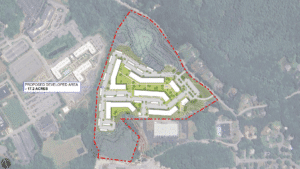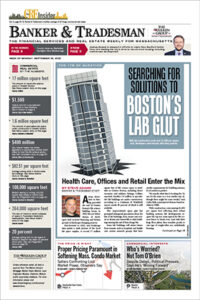Orlando, Florida development company ZOM Living has proposed the biggest apartment project to date that’s designed to take advantage of the MBTA Communities zoning law.
The company first entered the Boston market in 2021 with a controversial apartment proposal at Braintree’s South Shore Mall. Its new project, at 37 Powers Road in Westford, would see 530 units in several 4-story buildings and one amenity building rise on the site of a 35.62-acre storage lot owned by landscape and building materials supplier Westford Earth Materials.
“We want to create a neighborhood that feels and smells and looks like a neighborhood,” Brian O’Conner, a partner in project architects Cube3, told the Westford Planning Board earlier this month. “We’ve organized buildings and amenities for residents in a way that activates this central green space and creates a kind of neighborhood square.”
The ZOM proposal would represent the largest development parcel included in Westford’s MBTA Communities district, just edging out the 31.78-acre 1 Robbins Road office property nearby. Like only a handful of towns, Westford officials and Town Meeting members used the MBTA Communities rezoning requirement to try to add space for thousands of new housing units to be built, by-right, in the Westford Technology Park and several smaller districts strung along the Littleton Road commercial corridor.
Citing a dramatic drop in office utilization in the city’s office parks, a strategic desire to grow the local tax base and affordable housing stock, plus surveys showing preferences that development be concentrated in existing commercial areas, town officials approved zoning that created the theoretical capacity to add 4,873 new apartments instead of the state-mandated 924 units.
When ZOM executives presented conceptual plans for their Powers Road development to the town Planning Board earlier this month, officials urged them to find ways to create both vehicle and pedestrian connections across the site, to more evenly distribute car traffic to the main streets that surround the roughly 225-acre Westford Technology Park area. Town officials described their desire to make the Technology Park neighborhood into a cohesive district that’s conducive to walking and cycling instead of driving for many basic errands.
Town officials and ZOM’s attorney suggested that the state’s MBTA Communities Catalyst Fund could be used to pay for some of the necessary infrastructure upgrades to enable this objective.







